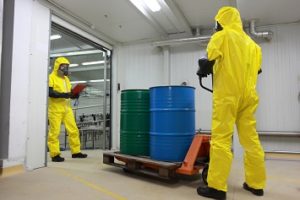Hazardous waste generators are required to count their hazardous waste in order to determine their generator status. The U.S. Environmental Protection Agency’s (EPA) new Hazardous Waste Generator Improvements Rule, which is effective May 30, 2017, on the federal level, includes a consolidated provision on determining your generator status. Here are some tips for counting your hazardous waste.

endopack / iStock / Getty Images Plus / Getty Images
Note: Always check with your state. Many states have stricter and/or additional hazardous waste requirements than the federal.
As a hazardous waste generator, you are required to determine your generator status or category by counting how much hazardous waste you have on-site. A generator’s category is based on the amount of hazardous waste generated each month and may change from month to month. Under the new Hazardous Waste Generator Improvements Rule, if you generate hazardous waste you fall into one of three categories:
- Large quantity generator (LQG)
- Small quantity generator (SQG)
- Very small quantity generator (VSQG)
VSQG is the most desirable category to be in as it has the fewest requirements. By accurately counting your hazardous waste, you can better control your monthly amounts and potentially remain or be in a lower category.
Four Basic Steps
There are four basic steps to take when you count your hazardous waste every month:
- Count separately the total amount of acute hazardous waste and the total amount of nonacute hazardous waste generated in the calendar month.
- Subtract from each total any amounts of waste exempt from counting (see below);
- Determine separately the resulting generator categories for the quantities of acute and nonacute hazardous waste generated (see Table);
- Compare the resulting generator categories and apply the more stringent generator category to the accumulation and management of both nonacute hazardous waste and acute hazardous waste generated for that month.
Table: Generator Categories Based on Quantity of Waste Generated in a Calendar Month
| Quantity of acute hazardous waste | Quantity of nonacute hazardous waste | Quantity of residues from a cleanup of acute hazardous waste | Generator Category |
| >1 kg | Any amount | Any amount | LQG |
| Any amount | >1,000 kg | Any amount | LQG |
| Any amount | Any amount | >100 kg | LQG |
| <1 kg | >100 kg and <1,000 kg | <100 kg | SQG |
| <1 kg | <100 kg | <100 kg | VSQG |
What’s Exempt from Counting?
When making your monthly quantity-based hazardous waste determinations, you must include all hazardous waste except hazardous waste that is:
- Exempt from regulation under 40 CFR 261.4(c) through (f) (i.e., waste generated in certain product or raw material tanks or conduits, and certain samples); 40 CFR 261.6(a)(3) (i.e., reclaimed industrial ethyl alcohol, certain scrap metals, and certain hazardous waste fuels and oils produced from oil-bearing hazardous waste), 40 CFR 261.7(a)(1) (i.e., hazardous waste remaining in an empty container or a liner removed from an empty container), or 40 CFR 261.8 (i.e., PCB waste regulated under the Toxic Substances Control Act;
- Managed immediately upon generation only in on-site elementary neutralization units, wastewater treatment units, or totally enclosed treatment facilities;
- Recycled, without prior storage or accumulation, only in a regulated on-site process;
- Used oil managed under the used oil management requirements;
- Spent lead-acid batteries that are being reclaimed and managed under 40 CFR 266.80;
- Universal waste;
- A hazardous waste that is an unused commercial chemical product that is generated solely as a result of a laboratory clean-out conducted at an eligible academic entity; or
- Managed as part of an episodic event in compliance with the conditions of the new provisions for episodic generation that will be found at 40 CFR 262.230 to 262.233.
In addition to these hazardous wastes that are exempt from counting in your monthly quantity-based determinations, there other hazardous wastes that you are not required to include. Tune into tomorrow’s Advisor for a look at these and some tips for counting mixtures.
